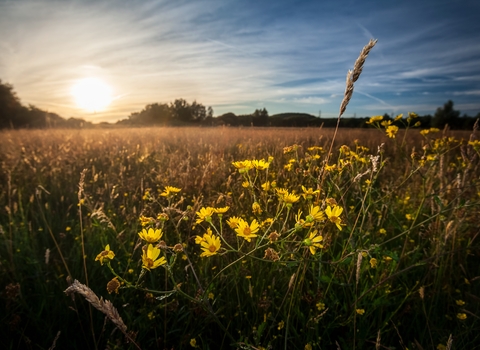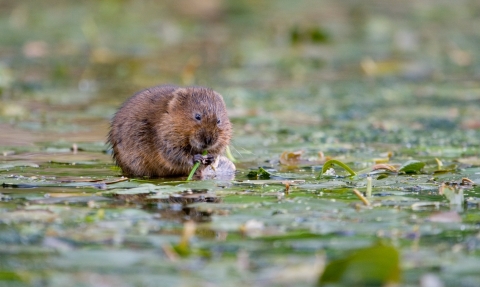
WildNet - Tom Marshall
Water Voles on the Gwent Levels
In 2012, we successfully re-introduced water voles back onto Magor Marsh nature reserve, on the Gwent Levels, where they are still thriving today. Following the success of this reintroduction, we are now looking to extend the project to encompass the western side of the Gwent Levels (Wentlooge).
Our Wentlooge Water Vole Reintroduction Feasibility Project, funded by Welsh Government through the Nature Networks Fund, launched in 2024.
Ratty Goes West! The Wentlooge Water Vole Reintroduction Feasibility Project
Our long-term vision is for Water Voles to be thriving all across Gwent’s waterways. It is only with a widespread, and well-connected distribution that the decline can be reversed, allowing the species to weather the challenges of the future. At present, we have quite limited knowledge as to the status of Water Voles beyond the eastern Gwent Levels and without a good understanding of their whereabouts or numbers, we cannot effectively protect them and their habitats.
Following the success of the reintroduction at our Magor Marsh Nature Reserve, Gwent Wildlife Trust are now looking to extend the project to encompass the western side of the Gwent Levels. The two sides of the Gwent Levels are split in half by the River Usk and the city of Newport, which we believe may be a barrier to our reintroduced population dispersing westwards. However, without sufficient research we can’t be sure if the reintroduced population has failed to spread, or if there are any surviving remnant populations.
To answer these questions our new Wentlooge Water Vole Reintroduction Feasibility Project aims to survey the Wentlooge Level (western side of the Gwent Levels), between the River Usk and Cardiff, for the presence of Water Vole and American Mink. The project will also assess the availability, connectivity and condition of habitats, and ultimately conclude whether it is feasible to reintroduce Water Voles here. The Project is generously funded by the Nature Networks Fund, which is administered by National Lottery Heritage Fund and funded by the Welsh Government.
You can help the Water Vole on the Gwent Levels!
To help us achieve this we need volunteers to help us carry out Water Vole and American Mink surveys on the Gwent Levels. That’s where you come in! You don’t need any special biological knowledge as we will provide training for you – all you need is enthusiasm!
We would also love to hear from landowners who will permit us access to their land to undertake Water Vole and American Mink surveys, as well as for siting mink traps which would allow us to humanely dispatch and reduce Mink numbers. This is a necessary step to ensure any future release of Water Voles doesn’t fail due to excessive levels of predation.
If you would like to get involved or would like any further information, please contact Kevin Donovan (Swyddog Prosiect Llygod Pengrwn y Dŵr | Water Vole Project Officer) on kdonovan@gwentwildlife.org 01600 740600 or 07768 808986
About Water Voles
Water voles have the unfortunate claim to fame of being the fastest declining mammal in the UK.
Water voles are a native species and until the 1950s, they flourished in Wales. Sadly, numbers have been dramatically declining, as they were impacted by habitat loss and preyed on by a non-native species, the American mink. This combination has meant up to 90 per cent of the UK's water vole population, have become extinct during the past few decades.
They may not be the most conspicuous of our wetland wildlife but they play a vital role in shaping their habitats for the benefit of many other species.
What do they need to thrive?
At twelve inches long (including their furry tail), water voles are our largest vole species and they need a lot of food and space to thrive. They eat over 200 different kinds of plants and consume up to 80% of their body weight each day.They live in burrows that they excavate in the banks of waterways and don’t stray far from the water so need a good variety and cover of plants within easy reach of the water's edge. They are very territorial and can defend territories up to 200 metres long so they need a lot of space to spread out in.
Water Vole Habitat
In Britain, nearly all colonies of Water Voles live in watery habitats, building networks of burrows into the banks of wet ditches, slow-moving streams, ponds and lakes. They are almost exclusively herbivorous and need to eat up to 80% of their body weight every day. An abundance of bankside vegetation is not only an important food source for them, but also provides cover from their many predators.
Water Vole Conservation - Threats and Predation
Water Vole us a defense mechanism involving plopping into the water, kicking up a screen of dirt and darting into a burrow. This method is effective against their natural predators, but the rise in non-native, invasive American Mink has spelled disaster for the Water Vole. This stealthy hunter is fast and slender, and female and young Mink are small enough to chase Water Voles into their burrows, leaving them with no escape.
This recent predator has exerted additional pressure on the Water Vole, which was already suffering the impacts of decades of habitat loss, degradation and fragmentation. By 1998 the population had already declined by an estimated 90%. The National Water Vole Database Project Report, published by The Wildlife Trusts on December 23rd, 2024, identified that declines in Water Vole populations are ongoing, with a 39% decrease in the number of areas occupied by Water Voles compared to the 2006 baseline figure. The first official Red List of British Mammals (2020) classed Water Voles within the ‘Vulnerable’ threat category, meaning they are at imminent risk of extinction.
The outlook isn’t all doom and gloom however, as targeted conservation work in recent decades has managed to slow and, in some cases, reverse declines at the local scale. Water Voles have also been successfully reintroduced to places where they had already gone extinct, including our reintroduction at Magor Marsh Nature Reserve on the Gwent Levels.
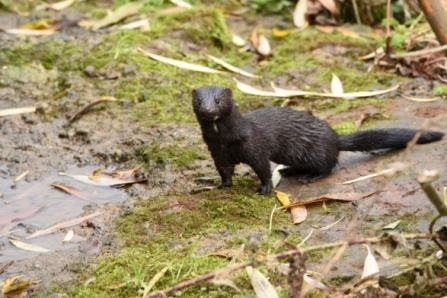
Jeff Chard
A future in the Gwent Levels
To secure their future on the Gwent Levels, we need to ensure the water vole population has room to grow, and for that we need to work on a landscape-scale.
With funding from HLF, the Living Levels Partnership has been enabling us to work with landowners to restore key wetland habitats across the Levels to give them, along with many others, a home to thrive in. And our new Nature Reserve at Bridewell Common, purchased in 2019 thanks to the generous support of our members, a legacy from Pat Gorvin and grant funding, will provide further protected habitat.
How to spot a Water Vole
Water Voles are semi-aquatic rodents and the largest of our vole species in Britain. They are sometimes also referred to as the ‘water dog’ or the ‘water rat’, which hints as to why the Water Vole character in Kenneth Grahame’s tale The Wind in the Willows was called Ratty! They are easily confused for Brown Rats too, especially when seen swimming, but their blunt noses and hidden ears are a giveaway.
Even as their numbers increase, it’s still rare to actually see a water vole. The best time to look for them is in the summer months when the young are out and about but you are more likely to hear them than see them. Listen out for them munching on plants or as they enter the water with a loud ‘plop’.
The key to looking for water voles is to look out for signs of their presence and then keep very still and quiet and with patience, and luck, you may see one.
Here are some of the signs to look out for:
Footprints
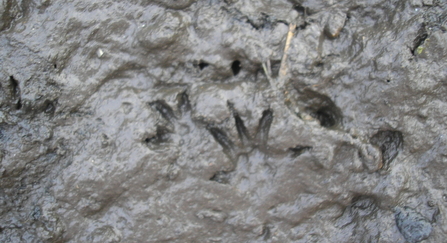
WildNet - Faye Davies
You may spot their delicate star-shaped footprints in muddy banks.
Burrows
Lowri Watkins
Look out for a tennis ball-sized hole in the bank surrounded by trimmed vegetation, sometimes with neat ‘lawns’ of grass outside.
Food remains
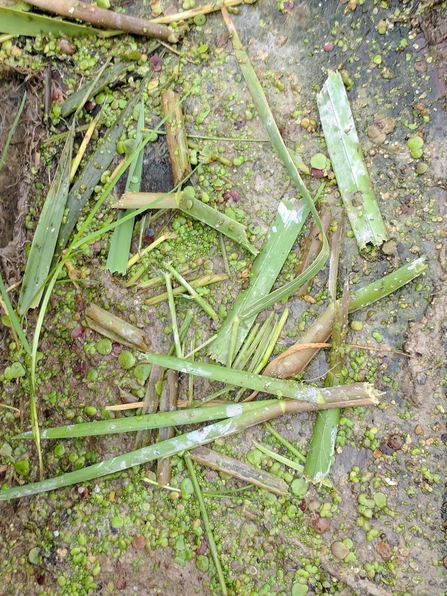
Lowri Watkins
You may find piles of nibbled plant stems near the water's edge. They bite them off at 45 degree angle and then hold them in their front paws to eat.
Latrines
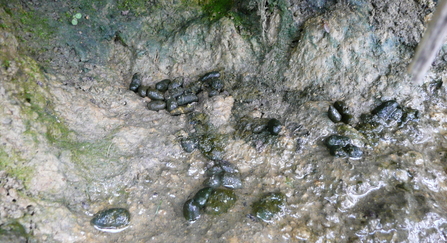
WildNet - Karen Lloyd
Water voles use latrines to help mark their territory so look out for a pile of small, odour-less droppings along the banks.
The Magor Marsh Reintroduction in 2012
It’s said that the Gwent Levels (with its c800 miles of interconnected waterways) once supported a thriving population of Water Voles, but by the early 2000s surveys found them to be locally extinct. In line with the national picture, this was attributed to adverse changes in the landscape and increasing predation pressure from non-native American Mink.
With ample good quality habitat still available and increased awareness of sympathetic management approaches, it was concluded that Water Voles could be returned to the eastern Gwent Levels, as long as the American Mink population could be reduced. A steering group was established and included representatives from Gwent Wildlife Trust, Natural Resources Wales, the Internal Drainage Board, RSPB, Local Authorities and expert advice from the late Rob Strachan and the Derek Gow Consultancy. The ambitious reintroduction project was funded by the (then) Heritage Lottery Fund and included the release of over two hundred Water Voles to our Magor Marsh Nature Reserve between 2012 - 2015. We’ve been monitoring them ever since.
The reintroduction was considered a success, with the Water Voles having spread out far beyond our nature reserve, and sightings coming in from 10km away. We believe they are now present on most stretches of suitable watercourse on the eastern side of the Gwent Levels, having established a robust metapopulation.

The current Water Vole Project is funded by the National Lottery Heritage Landscape Nature Networks Fund.
The Wentlooge Water Vole Reintroduction Feasibility Project is funded by the Nature Networks Fund, which is administered by National Lottery Heritage Fund and funded by the Welsh Government.


